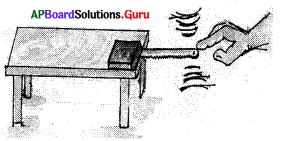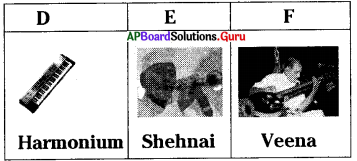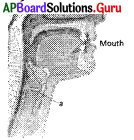Practice the AP 8th Class Physical Science Bits with Answers Chapter 6 Sound on a regular basis so that you can attempt exams with utmost confidence.
AP State Syllabus 8th Class Physical Science Bits 6th Lesson Sound with Answers
Choose the correct answer.
Question 1.
Sound can’t travel in
A) solid
B) liquid
C) gas
D) vacuum
Answer:
D) vacuum
Question 2.
The unwanted sound in our surroundings leads to ………..
A) conservation
B) emission
C) absorption
D) pollution
Answer:
D) pollution
![]()
Question 3.
The intensity of sound is measured in
A) Decibel
B) Meter
C) Kg
D) Newton
Answer:
A) Decibel
Question 4.
The number of vibrations per second is called
A) wavelength
B) amplitude
C) frequency
D) none of these
Answer:
C) frequency
Question 5.
The shrillness of a sound is called
A) pitch
B) velocity
C) wavelength
D) none
Answer:
A) pitch
Question 6.
An object which moves to and fro motion from rest known as ………..
A) Linear motion
B) Vibration
C) Simple motion
D) Angular motion
Answer:
B) Vibration
![]()
Question 7.
The number of vibrations produced per second is known as ……..
A) Frequency
B) Shrillness
C) Vibration limit
D) Decibels
Answer:
A) Frequency
Question 8.
The oval window has the surface area ………. of the eardrum.
A) 1/10
B) 2/10
C) 2/20
D) 1/20
Answer:
D) 1/20
Question 9.
The unit for intensity of sound is
A) Hertz
B) Decibel
C) Newton
D) Ampere
Answer:
B) Decibel
Question 10.
Audible range is
A) 20 cycles /sec – 2,000 cycles/sec
B) 20 cycles /sec – 20,000 cycles/sec
C) 200 cycles /sec – 20,000 cycles/sec
D) 20 cycles /sec – 2,00,000 cycles/sec
Answer:
B) 20 cycles /sec – 20,000 cycles/sec
Question 11.
Pitch depends upon ………. of the sound.
A) frequency
B) amplitude
C) intensity
D) none of these
Answer:
A) frequency
![]()
Question 12.
Intensity of sound depends on
A) pitch
B) amplitude
C) frequency
D) none of these
Answer:
B) amplitude
Question 13.
The unit decibel expressed in the name of ………..
A) Graham Bell
B) Newton
C) Pascal
D) Ampere
Answer:
A) Graham Bell
Question 14.
……….. produce more shrillness sound.
A) Man
B) Woman
C) Child
D) None of these
Answer:
C) Child
Question 15.
………… can’t travel in vacuum.
A) Solid
B) Liquid
C) Gas
D) Sound
Answer:
D) Sound
Question 16.
The intensity of ………. is measured in decibel.
A) sound
B) meter
C) kg
D) newton
Answer:
A) sound
![]()
Question 17.
Length of vocal cords in man is nearly ……… mm.
A) 20
B) 10
C) 5
D) 1
Answer:
A) 20
Question 18.
Length of vocal cords in women is ……….. mm.
A) 20
B) 15
C)10
D) 5
Answer:
B) 15
Question 19.
The smallest audible sound is ……… dB.
A) 0
B) 30
C) 60
D) 80
Answer:
A) 0
Question 20.
The sounds which are pleasant to hear and are in order are called ………..
A) music
B) noise
C) both
D) none of these
Answer:
A) music
Question 21.
Sounds which are irregular and unpleasant to hear are called ……….
A) music
B) noise
C) both
D) none of these
Answer:
B) noise
![]()
Question 22.
The sounds that normal human being can listen are called ………… sounds.
A) infrasonics
B) ultrasonics
C) audible
D) none of these
Answer:
C) audible
Question 23.
The sound produced in our normal conversation is about ………. dB.
A) 0
B) 120
C) 60
D) 140
Answer:
C) 60
Question 24.
Choose correct option for sure matching.
Group – A — Group – B
1. Pitch — a) Pleasant to hear
2. Intensity of sound — b) 20 cycles / second to 20,000 cycles /second
3. Music — c) Frequency
4. Noise — d) Amplitude
5. Audible — e) Unpleasant to hear
frequency range
A) 1 – a, 2 – b, 3 – c, 4 – d, 5 – e
B) 1 – b, 2 – c, 3 – d, 4 – e, 5 – a
C) 1 – c, 2 – d, 3 – a, 4 – e, 5 – b
D) 1 – d, 2 – e, 3 – a, 4 – b, 5 – c
Answer:
C) 1 – c, 2 – d, 3 – a, 4 – e, 5 – b
Question 25.
Jalatarang works with the difference in
A) air column
B) string length
C) area of membrane
D) none
Answer:
A) air column
![]()
Question 26.
Sound will produce, when a body
A) moves
B) falls
C) flies
D) vibrates
Answer:
D) vibrates
Question 27.
Vocal cords are present in
A) Larynx
B) Mouth
C) Nose
D) Stomach
Answer:
A) Larynx
Question 28.
Number of vocal cords present in our throat is
A) 1
B) 2
C) 3
D) ∞
Answer:
B) 2
Question 29.
Sound can travel in
A) solids
B) liquids
C) gases
D) above all
Answer:
D) above all
Question 30.
Loudness and feebleness of sounds depends upon
A) frequency
B) pitch
C) amplitude
D) above all
Answer:
C) amplitude
![]()
Question 31.
Vibrate a bell and touch it. You may feel
A) heat
B) cool
C) vibration
D) shock
Answer:
C) vibration
Question 32.
Guess the object which produces sound without vibrate itself.
A) tuning fork
B) bell
C) air
D) no object
Answer:
D) no object
Question 33.
If no part in this universe vibrates, then the consequence is
A) total silence
B) total fall down
C) total colourful
D) total noise
Answer:
A) total silence
Question 34.
What is the intensity of the sound at out side of the Glass jar?

A) less intensity
B) more intensity
C) same intensity of original sound
D) zero intensity
Answer:
D) zero intensity
![]()
Question 35.

From the given experiment, we may produce.
A) friction
B) light
C) heat
D) sound
Answer:
D) sound
Question 36.
The required apparatus to prove that sound has energy are
A) glass, rubber band, balloon, cell phone, sugar
B) glass, water, sugar, rubber band, whistle
C) 6 glasses, water, spoon
D) any one of the above
Answer:
A) glass, rubber band, balloon, cell phone, sugar
Question 37.
How do you produce a feeble sound ?
A) By striking gently a body
B) By striking hardly a body
C) By increasing length of a body
D) By decreasing length of a body
Answer:
A) By striking gently a body
Question 38.

From the given experiment we can produce sounds to differentiate
A) Low pitch, high pitch sounds
B) Low amplitude, high amplitude sounds
C) Low pitch, high intensity sounds
D) Low intensity, high intensity sounds
Answer:
A) Low pitch, high pitch sounds
![]()
Question 39.

How do you produce high intensity sound in the given experiment?
A) Use small force to vibrate the blade
B) Use great force to vibrate the blade
C) Reduce length of the blade and vibrate
D) Extend the length of the blade and vibrate
Answer:
B) Use great force to vibrate the blade
Question 40.

Adjacent figure represents an activity ………..
A) Sound produced by hack-saw blade
B) Vibration of hack-saw blade
C) Both A and B
D) None
Answer:
C) Both A and B
Question 41.

Given figure represents about
A) Musical instrument
B) Cell phone
C) Tumbler closed with cloth
D) Sound has energy
Answer:
D) Sound has energy
Question 42.
………. contains three small bones.
A) Inner ear
B) Outer ear
C) Middle ear
D) None of these
Answer:
C) Middle ear
![]()
Question 43.
A 30 dB sound is …………. times more powerful than the total silence.
A) 10
B) 100
C) 1000
D) 10000
Answer:
C) 1000
Question 44.
Choose correct option for sure matching.
Group – A — Group B
1. A whisper — a) 110 dB
2. Normal conversation — b) 140 dB
3. A lawnmower — c) 15 dB
4. A car horn — d) 60 dB
5. A jet engine — e) 90 dB
6. A gunshot or fire cracker — f) 120 dB
A) 1 – c, 2 – d, 3 – e, 4 – a, 5 – f, 6 – b
B) 1 – a, 2 – b, 3 – c, 4 – d, 5 – e, 6 – f
C) 1 – b, 2 – c, 3 – d, 4 – e, 5 – f, 6 – a
D) 1 – c, 2 – d, 3 – e, 4 – f, 5 – a, 6 – b
Answer:
A) 1 – c, 2 – d, 3 – e, 4 – a, 5 – f, 6 – b
Question 45.
| Instrument | Vibrating part |
| A | Membrane, air inside hollow body |
| Flute | Air inside hollow body |
| Veena | Vibrating strings |
‘A’ may be
A) Tabala
B) Guitar
C) Harmonium
D) Shehnai
Answer:
A) Tabala
![]()
Question 46.


In the given pictures instruments works with vibrating its strings are
A) B
B) C, D
C) A, F
D) A, D, F
Answer:
C) A, F
Question 47.
| Person | Length of vocal cord |
| man | 20 mm |
| woman | 15 mm |
| children | 10 mm |
Shrillness of sound appears in
A) man
B) woman
C) children
D) above all
Answer:
C) children
Question 48.

The given figures shows
A) sound travels in solids
B) sound travels in liquids
C) sound travels in vacuum
D) above all
Answer:
A) sound travels in solids
![]()
Question 49.

In the above waves, which one has more frequency?
A) A
B) B
C) C
D) D
Answer:
A) A
Question 50.
From the above diagrams, which one has more wavelength?
A) A
B) B
C) C
D)D
Answer:
D) D
Question 51.
From the above diagram ‘A’ possesses
A) Less frequency and more wavelength
B) High frequency and less wavelength
C) High frequency and high wavelength
D) Less frequency and less wavelength
Answer:
B) High frequency and less wavelength
Question 52.
From the above diagrams ‘A’ and ‘C’, which one has more amplitude?
A) A
B) C
C) Both A and C
D) Neither ‘A’ nor ‘C’
Answer:
B) C
Question 53.
| Blade | Vibrations | Amplitude |
| A | 1500 | 0.005 m |
| B | 1000 | 0.05 in |
| C | 100 | 0.01 in |
From above table, which blade has more intensity?
A) A
B) B
C)C
D) None
Answer:
B) B
![]()
Question 54.
From above table, which blade has more pitch?
A) A
B) B
C) C
D) All are equal
Answer:
A) A
Question 55.
Identify the name of the activity in the figure the girl was doing.

A) Blowing air
B) Jalatarang
C) Striking the glass
D) None
Answer:
B) Jalatarang
Question 56.

Which of the following property shows by this activity?
A) Propagation of sound
B) Pitch of sound
C) Sound has energy
D) Sound has intensity
Answer:
A) Propagation of sound
Question 57.

Part ’a’ is
A) Larynx
B) Vocal cord
C) Trachea
D) Tongue
Answer:
B) Vocal cord
![]()
Question 58.

Name of these figures is
A) Larynx
B) Vocal cords
C) Lungs
D) Eyes
Answer:
B) Vocal cords
Question 59.

‘d’ and ‘λ’ indicates
A) wavelength and frequency
B) wavelength and amplitude
C) amplitude and wavelength
D) frequency and amplitude
Answer:
C) amplitude and wavelength
Question 60.
Match the great musicians.
a) Bismilla Khan — (i) Tabala
b) Chittibabu — (ii) Shehnai
c) Zakir Hussain — (iii) Veena
A) a – ii, b – iii, c – i
B) a -1, b – ii, c – iii
C) a – ii, b – i, c – iii
D) a – iii, b – ii, c – i
Answer:
A) a – ii, b – iii, c – i
Question 61.
All the human beings and animals are communicate their feeling by
A) Producing light
B) Producing heat
C) Producing sound
D) Above all
Answer:
C) Producing sound
![]()
Question 62.
The sound produced by near total silence is
A) 0 dB
B) 15 dB
C) 60 dB
D) 110 dB
Answer:
A) 0 dB
Question 63.
Sound travel much faster in ………..
A) solids
B) liquids
C) gases
D) plasma
Answer:
A) solids
Question 64.
Tabala is an instrument of ……….. type.
A) drum instrument
B) fringed instrument
C) stringed instrument
D) none of these
Answer:
A) drum instrument
Question 65.
Flute is an instrument of ……….. type.
A) drum instrument
B) fringed instrument
C) stringed instrument
D) none of these
Answer:
B) fringed instrument
Question 66.
Guitar is an instrument of ……… type.
A) drum instrument
B) fringed instrument
C) stringed instrument
D) none of these
Answer:
C) stringed instrument
![]()
Question 67.
………… is the important organ in the human body to produce sound.
A) Ear
B) Larynx
C) Nose
D) Muscles
Answer:
B) Larynx
Question 68.
The intensity of sound of car horn is ……… dB.
A) 140
B) 110
C) 60
D) 140
Answer:
B) 110
Question 69.
The intensity of sound of jet engine ……… dB.
A) 140
B) 120
C) 60
D) 80
Answer:
B) 120
Question 70.
The intensity of sound of a fire cracker is …….. dB.
A) 140
B) 120
C) 60
D) 110
Answer:
A) 140
Question 71.
The intensity of near total silence is …….. dB.
A) 0
B) 60
C)110
D) 120
Answer:
A) 0
![]()
Question 72.
Why does a cracker make a loud sound?
A) It vibrates air molecule
B) It burns with air
C) It gives light with heat
D) It gives fumes
Answer:
A) It vibrates air molecule
Question 73.
Some diwali crackers harmful to ears. Due to they produce
a) high pitch sound
b) high intensity sound
c) high amplitude sound
d) high frequency sound
A) a, d
B) a
C) b, c
D) d
Answer:
C) b, c
Question 74.
High intensity sounds causes
A) anger
B) frustation
C) express negativity
D) above all
Answer:
D) above all
Question 75.
Raju cannot hear this sounds with
A) 10 Hz
B) 200 Hz
C) 200, 000 Hz
D) Above all
Answer:
B) 200 Hz
![]()
Question 76.
Which of the sound is not harmful?
A) Sound with 60 dB
B) Sound with 120 dB
C) Sound with 100 dB
D) B and C
Answer:
D) B and C
Question 77.
How do you control sound pollution ?
A) By plantation
B) By attach silences to the vehicles
C) Reducing sounds through loud speakers
D) Above all
Answer:
D) Above all
Question 78.
Audible frequency range
A) 2 vibrations/sec – 20 vibrations / sec
B) 20 vibrations / sec – 20,000 vibrations / sec
C) 20 vibrations / sec – 200 vibrations / sec
D) 10 vibrations / sec – 20 vibrations / sec
Answer:
B) 20 vibrations / sec – 20,000 vibrations / sec
Question 79.
Match the following.
A — B
1) Tabla — a) Stringed instrument
2) Flute — b) Membrane instrument
3) Veena — c) Air blowing instrument
Choose the correct answer.
A) 1 – c, 2 – b, 3 – a
B) 1 – c, 2 – a, 3 – b
C) 1 – b, 2 – a, 3 – c
D) 1 – b, 2 – c, 3 – a
Answer:
D) 1 – b, 2 – c, 3 – a
![]()
Question 80.
Find the odd one out from the parts of speech organs.
A) Vocal cards
B) Lips
C) Tongue
D) Ear
Answer:
D) Ear
Question 81.
Read the following sentences.
i) We came to know that sound travels through the solids,
ii) Keep your ear on the table.
iii) We can hear a peculiar sound,
iv) Tap the table at other end with hand.
A) i, iii, ii, iv
B) iv, ii, iii, i
C) ii, iv, iii, i
D) iii, i, ii, iv
Answer:
C) ii, iv, iii, i
Question 82.
1) Units of intensity of sound is decible.
2) The number of vibrations per minute is called frequency.
A) 1-True, 2-True
B) 1-False, 2-True
C) 1-True, 2-False
D) 1-False, 2-False
Answer:
C) 1-True, 2-False
Question 83.
A bird makes high pitch sound and a lion makes low pitch roar. Predict the reason.
A) Bird produces high frequency sound
B) Lion produces high frequency sound
C) Bird size is small
D) Lion size is big
Answer:
A) Bird produces high frequency sound
![]()
Question 84.
A blade made 3000 vibrations in 10 seconds. Then the frequency of the blade is ………….. vibr. / sec.
A) 30
B) 300
C) 3000
D) 30000
Answer:
B) 300
Question 85.
The loudness of sound exceeds ……….. are harmful for the ear.
A) 80 dB
B) 60 dB
C) 50 dB
D) 55 dB
Answer:
A) 80 dB
Question 86.
Apparatus required in an experiment to find the relation between intensity of sound and amplitude.
A) Wooden table, brick, hack – saw blade
B) Wooden table, blade, brick
C) Stand, simple pendulum, hack – saw blade
D) Wooden table, stick, brick
Answer:
A) Wooden table, brick, hack – saw blade
Question 87.
Laahi is asked to conduct an experiment by giving bucket, water and two stones. After doing the experiment what is her observation?
A) Water is needed for the production of sound.
B) Sound travels through water.
C) Sound travels through air.
D) Sound is produced by touching two stones.
Answer:
B) Sound travels through water.
Question 88.
High intensity sound causes sound pollution. Suggest the precautions to avoid sound pollution
a) ask the people to decrease the usage of loud speakers
b) to arrange silencers to motor vehicles
c) encourage them to burn crackers
d) encourage them to increase plantation
A) a, c and d
B) a, b and d
C) b, c and d
D) a, b and c
Answer:
B) a, b and d
![]()
Question 89.
Adult women, adult men, lion, infants are having different pitch in their voices. The right order of their pitch
A) Lion > Adult men > Adult women > infant
B) Lion < Adult men < Adult women < infant C) Adult women > Infant > Lion > Adult men
D) Adult women > Adult men > Lion > infant
Answer:
B) Lion < Adult men < Adult women < infant
Question 90.
Which of the statement is incorrect?
A) Sound has energy.
B) Sound requires a medium to travel.
C) Vibrations produce sound.
D) Sound produce vibrations.
Answer:
D) Sound produce vibrations.
Question 91.
P: Infrasonics does not produce sound pollution
Q: Ultrasonics produce sound pollution
A) P is false, Q is true
B) P, Q both are true
C) P, Q both are false
D) P is true, Q is false
Answer:
B) P, Q both are true
Question 92.
P: Intensity of sound depends on amplitude
Q: Pitch of the sound depends on Frequency
A) P, Q both are false
B) P is true, Q is false
C) P is false, Q is true
D) P, Q both are true
Answer:
D) P, Q both are true
![]()
Question 93.
Match the following.
Instrument Process of producing sound
a) Tabala i) Vibrating air column
b) Harmonium ii) Vibrating upper layer and air column
c) Guitar iii) Vibrating string
A) a – ii, b – iii, c – i
B) a – iii, b – i, c – ii
C) a – ii, b – i, c – iii
D) a-i, b—ii, c-iii
Answer:
C) a – ii, b – i, c – iii
(94 -95)
| Near total silence | 0 db |
| A whisper | 15 db |
| Normal conversation | 60 db |
| A lawn mover | 90 db |
| A car horn | 110 db |
| Jet engine | 120 db |
| Fire cracker | 140 db |
The above table indicates the sounds and their intensities. Answer the following by observing the above table.
Question 94.
Intensity of sound produced by a lawn mover
A) 60 db
B) 90 db
C) 110 db
D) 15 db
Answer:
B) 90 db
Question 95.
The intensity of sound produced by Jet engine is more than the intensity of car horn. How many times is more?
A) 100 db
B) 1000 db
C) 20 db
D) 10 db
Answer:
D) 10 db
![]()
Question 96.

What do you know from the picture below?
A) Sound can travel through vacuum
B) Sound has energy
C) Sound produces vibrations
D) Medium is required for the sound to travel
Answer:
B) Sound has energy
Question 97.
Assertion (A): Humans cannot hear the sound produced by Bats.
Reason (R): Humans cannot hear the sounds with frequency greater than 20000 vibrations / sec.
A) Both “A” and “R” are correct but “R” is not correct reason for A
B) A is correct and R is not correct
C) Both A and R are not correct
D) Both A” and “R” are correct and “R” is the correct reason for A
Answer:
D) Both A” and “R” are correct and “R” is the correct reason for A
Question 98.
Predict why Deepak has closed his ears after hearing the sound of crickets?
A) Because of high wave length sound
B) Because of high pitch sound
C) Because of high amplitude sound
D) Because of high intensity sound
Answer:
B) Because of high pitch sound
Question 99.
Frequency is related to
A) Loudness
B) Pitch
C) Amplitude
D) Feebleness
Answer:
B) Pitch
Question 100.
The following is not the effect of sound pollution.
A) Loss of hearing
B) Sleeplessness
C) Hypertension
D) Loss of eye sight
Answer:
D) Loss of eye sight
![]()
Question 101.
The velocity if propagation of sound in ascending order is
A) Solid < liquid > air
B) Air < liquid < solid
C) Liquid < air < solid
D) Solid < air < liquid
Answer:
B) Air < liquid < solid
Question 102.
Intensity of sound can be measured in ……………
A) Meter/sec
B) Vibration/sec
C) Meter
D) Decible
Answer:
D) Decible
Question 103.
Which is the correct statement regarding blending?
A) A blend means alternating threads of cotton and polyester
B) Only synthetic fibres can be blended
C) Unique and different textures can be created through blending
D) Weak fibres can be produced
Answer:
C) Unique and different textures can be created through blending
Question 104.
Velocity of sound in vacuum
A) 0 meter/sec
B) 100 meter/sec
C) 250 meter/sec
D) 330 meter/sec
Answer:
A) 0 meter/sec
Question 105.
Velocity of the sound is maximum in
A) Solids
B) Liquids
C) Gases
D) Vacuum
Answer:
A) Solids
![]()
Question 106.
Length of vocal chords in men is 20mm, in women it is about 5 mm less and in children it is shorten than that. Length of the vocal chord determines the frequency and in turn determines the pitch.
The sound produced by a short vibrating blade has high pitch and by a long vibrating blade has a low pitch.
Which of the following can be said based on the above ?
A) Women’s voice have a higher pitch than men.
B) Children’s voice have a higher pitch than women.
C) Men’s voice have a higher pitch than women and children.
D) The voice of men and children have the same pitch.
Answer:
B) Children’s voice have a higher pitch than women.
Question 107.
Decibel is the unit for measuring intensity of sound. It is expressed in Decibels (dB). Some common sounds and their decibel ratings. Near total silence – 0 dB, A whisper -15 dB, Normal conversation – 60 dB, A lawnmower – 90 dB, A car horn -110 dB, A jet engine -120 dB. A gunshot or fire-cracker – 140 dB, If a person is being exposed to the sound of 80 dB con-tinuously it may lead to hearing problems.
Which of the following can be said based on the above?
A) Listening to whispering sounds continuously can lead to hearing problems.
B) Hearing to continuous explosive sounds of guns can lead to hearing problems.
C) Total silence can harm the ears and some sound is required for maintaining the health of ear drums.
D) Car horns and other vehicle horn sounds do not cause any damage to the ears.
Answer:
B) Hearing to continuous explosive sounds of guns can lead to hearing problems.